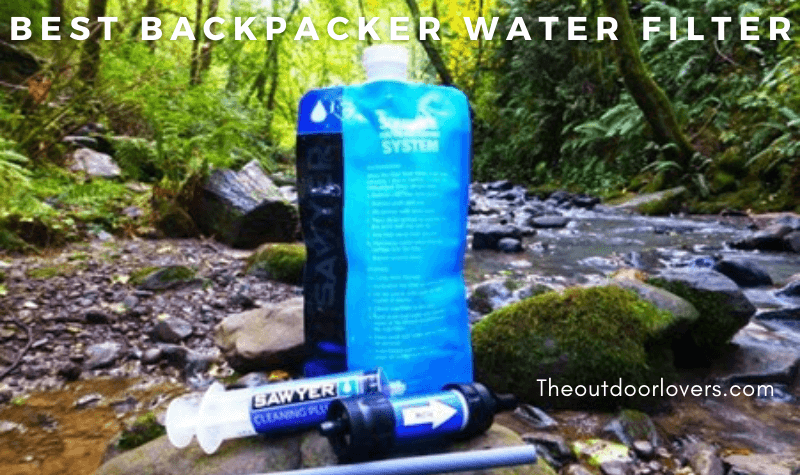When it comes to backpacking and camping, there are a lot of things that can go wrong. From getting lost in the woods to getting injured by an animal, you’re always at risk of something bad happening while you’re out in nature.
But what can you do if you find yourself out on the trail without access to clean drinking water? Luckily, we’ve got a solution! We’ve put together a list of the 4 best backpacker water filters available right now, so you’ll never have to worry about having access to clean drinking water again.
Also, before we move on to the list of reviews, we will first look at a comprehensive buying guide to the best backpacker water filter system that will help you choose the perfect one. So, without further ado, let’s get started!
If you want to jump off directly into the reviews, then you can do so by clicking HERE!
What are backpacking water Filters?
A backpacking water filter is a system used to cleanse water of impurities and make it safe to drink. There are many different types of filters available on the market, each with their own benefits and drawbacks.
The most common type of backpacking water filter is the pump-action filter. This type of filter uses a physical barrier to remove contaminants from water as it is pumped through the system.
Pump-action filters are typically very lightweight and can be easily carried in a backpack. However, they require regular maintenance and replacement parts can be expensive.
What are the different types of backpacking water filtering systems?
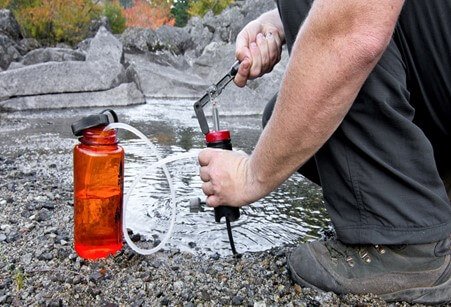
There are a variety of different backpacking water filtering systems available on the market, each with their own set of features and benefits. Here are some of the most prevalent choices:
- Gravity Filters: Gravity filters are one of the simplest and most effective ways to filter water while out on the trail. These devices use gravity to draw water through a filtration system, typically consisting of multiple layers of filters (including activated carbon) that remove contaminants from the water.
- Pump Filters: Pump filters work by using manual pumps or battery-powered motors to force contaminated water through an internal filtration system. These devices usually have multiple stages of filtration (including activated carbon), which effectively removes harmful bacteria and protozoa from your drinking supply.
- UV Water Filters: UV filters utilize ultraviolet light waves to kill microorganisms present in unclean water sources. While UV filters do not actually “filter” out contaminants like sediment or chemicals, they provide reliable protection against viruses, bacteria, and protozoa – making them ideal for homes and caravanning activities!
How much do backpacking water filtering systems usually cost?
It really depends on the quality of the filter and what brand you buy. Some filters can cost as little as $20 while others may be over $100. There are also different types of filters with varying levels of filtration power.
The more expensive options usually have a higher filtration level, but this isn’t always the case. It’s important to do your research before purchasing a water filter so that you know you’re getting a good quality product that will suit your needs.
Buying Guide to the Best Backpacking Water Filtering Systems
Looking for the best water filtering systems for backpacks? Not sure how to choose the best option? Well, don’t worry! In this buying guide, we will reveal 4 crucial factors that are a must to consider while looking for the best backpacking water filtering systems!
So, what are these factors and how do they affect your buying decision? Well, let’s find that out below!
1. Weight
Weight is one of the most crucial factors to consider while buying a backpacking water filtering system. A heavier filter can weigh you down and make your backpack feel uncomfortable. On the other hand, a lighter filter will be easier to carry and won’t add too much weight to your pack.
It’s important to consider how often you’ll need to use it. If you only plan on using the filter occasionally on camping or hiking trips, then a heavier model might not be an issue. However, if you anticipate using the filter frequently or for extended periods of time, then a lighter model would be ideal!
2. Filter or Purifier
The next thing you need to decide is whether you need a filter or a purifier. A filter will remove bacteria, protozoa, and sediment from water, while a purifier also removes viruses – which are much smaller than bacteria and protozoa and cannot be seen with the naked eye.
If you are unsure about which type of contaminants might be present in the water where you’ll be hiking or backpacking, it’s always better to err on the side of caution and choose a purifier over a filter! However, if the water is from a creek or a lake in the mountain or any other clean sources, a filter will do the job perfectly.
3. Ease of use
As you know, water is essential for survival. The body is made up of 60% water and we need to consume an average of 2 litres per day just to stay alive. However, in an emergency situation or when backpacking in the wilderness, clean drinking water can be hard to come by. That’s where a backpacking water filter comes in handy.
So, a good backpacking water filter should be easy to use so that you can get clean drinking water even when you’re far from civilization. There are many different types of filters on the market, but not all of them are created equal. Some require special adapters or hoses while others are difficult to operate due to their small size.
The best backpacking filters will be easy to set up and use without any hassle – even if you’re tired after a long day hike!
4. Price
Price is another important factor to consider while buying a backpacking water filtering system. Most sedimentation and gravity filters come around $20-50, however, if you want to go for a high quality filter, you can spend up to around $100-120!
My 4 Suggested Best Backpacking Water Filtering System:
1. Sawyer Products MINI Water Filtration System

The Sawyer MINI Water Filtration System is the perfect solution for clean water on the go. This high performance inline filter fits in the palm of your hand and weighs just 2 ounces, yet removes 99.9% of all bacteria and protozoa, and even 100% of microplastics from water sources.
The MINI can last up to 100,000 gallons and comes with two 16 ounce reusable squeeze pouches, two 7 inch drinking straws, and two cleaning plungers. It’s ideal for outdoor recreation, hiking, camping, scouting domestic and international travel, and even for survival.
Plus, each individual MINI unit is tested three times to performance standards by Sawyer prior to packaging ensuring you get a quality product each time. So, buy one now and be prepared for anything life throws your way!
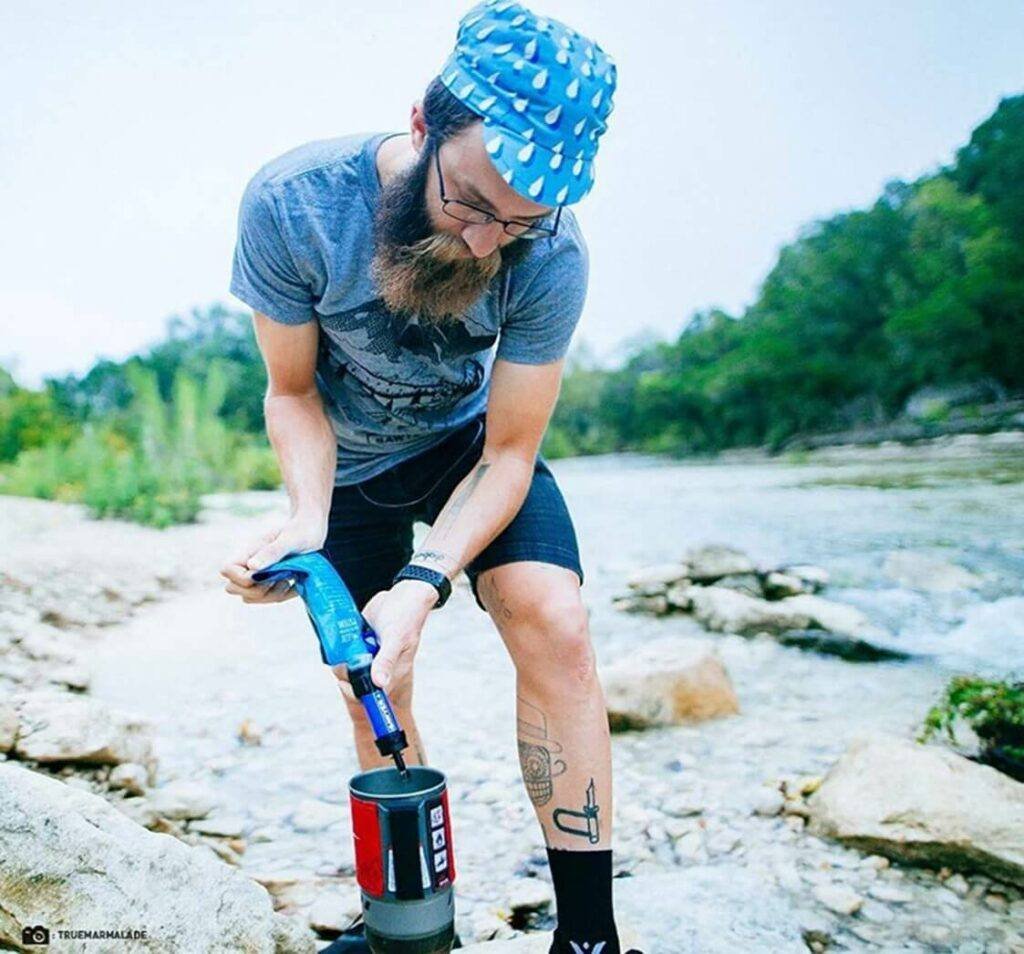
Features
- Cartridge life: 100000 Gallons
- Purification method: Hollow Fibre Membrane
- Weight: 0.5 Pounds
- Included container: 16 oz.
Pros
- Extremely portable and lightweight- weighs just 2 ounces.
- Removes 99.9 % of all bacteria.
- Can last up to 100,000 gallons.
- Ideal for outdoor recreation, hiking, camping, etc.
- Attaches to included drinking pouch, or even any other standard disposable water bottles.
Cons
- Pulling water directly from the straw can be a bit difficult!
If you’re looking for a water filtration system that’s lightweight and portable, the Sawyer Products MINI Water Filtration System is an ideal choice. It weighs just 2 ounces and attaches to included drinking pouch or any other standard disposable water bottles.
Plus, it even removes 99.9 % of all bacteria and has a lifespan of up to 100,000 gallons. This filter is ideal for outdoor recreation, hiking, camping, backpacking etc., as it’s so lightweight that you can easily carry it with you anywhere!
2. Survivor Filter Pro Water Purification System
Looking for a water filter that will give you clean, safe water without fail? Look no further than the Survivor Filter Pro Water Purification System. Multiple laboratories in the United States have independently determined that this system is highly effective against viruses, staph, parasites, and bacteria.
It also reduces heavy metals by up to 99.5% for mercury and 93% for lead – surpassing EPA standards. The shell is made of ABS material (the same as car bumpers), with a polysulfone medical grade ultrafilter and a food grade activated carbon inside. And there’s also a steel bar handle for extra support, making it very durable.
The filter features a flow rate of 500 millilitres per minute, so you can fill up a cup or jug quickly from any fresh water source – directly or using the pump to easily connect it to any portable hydration pack. Plus, if you ever have questions or problems with your product, customer service is available lifetime-guaranteed!
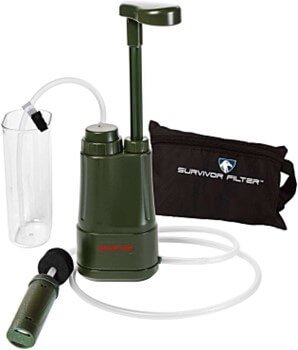
Features
- Cartridge life: 100000 Litres
- Purification method: Hollow Fibre Membrane, Activated Carbon
- Weight: 0.51 Pounds
- Flow rate: 500 Millilitres Per Minute
Pros
- Independently tested at multiple labs in the USA
- Capable of reducing heavy metals by up to 99.5%
- Extremely durable yet lightweight
- Has a decent flow rate of 500 millilitres per minute.
- There’s also a lifetime customer service from Survivor Filter
Cons
- You have to pump quite a bit to fill even a 32 oz container!
We’ve seen a lot of water purifiers on the market, and we can confidently say that the Survivor Filter Pro is one of the best. It’s incredibly durable, lightweight, and has an impressive flow rate of 500 millilitres per minute.
It also comes with a lifetime customer service from Survivor Filter, so you can be sure that you’ll always have someone to talk to if you ever have any problems with your product.
3. Katadyn Hiker Pro Transparent Water Filter
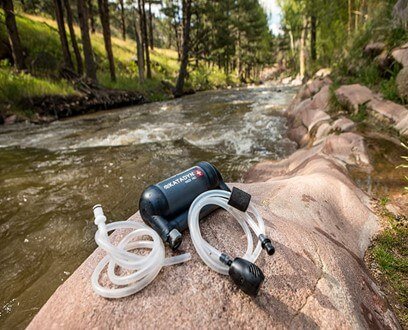
Looking for a water filter that meets all of your needs? Look no further than the Katadyn Hiker Pro Transparent Water Filter! This filter is ideal for backpackers, as it is ultralight weight (11oz) and compact in size, making it easy to carry with you on your adventures.
Additionally, its transparent design lets you see the filtration working – giving you peace of mind knowing that your water is being filtered properly. The filter is capable of filtering particles as small as 0.2 microns and features activated carbon at its core, which enhances flavour while reducing chemical levels.
Plus, the field cleanable filter protector screen helps extend cartridge life significantly. So why wait? Get out there and explore with confidence knowing that you have the best possible water filters at your disposal!
Features
- Capacity: 325 Millilitres
- Purification method: Activated Carbon
- Weight: 0.7 Pounds
- Flow rate: 1 Litre Per Minute
Pros
- Able to filter particles as small as 0.2 microns.
- Comes with an activated carbon core.
- Extremely lightweight (11 oz) and compact
- Features a transparent design that lets you see the filtration working.
- Helps reduce exposure to harmful bacteria and protozoan cysts.
Cons
- The filter could be more durable!
The Katadyn Hiker Pro Transparent Water Filter is the perfect choice if you’re looking for a lightweight and compact water filter that can be used with any type of water source.
It’s capable of filtering down to 0.2 microns, and it comes with an activated carbon core that helps reduce exposure to harmful bacteria and protozoan cysts. Plus, the transparent design lets you see the filtration working, so you’ll always know when it’s time to replace the cartridge.
4. MSR HyperFlow Backcountry Water Filter
The MSR HyperFlow Backcountry Water Filter is a microfilter that utilizes hollow fibre technology and advanced engineering to make water treatment highly mobile and easy to use. The hollow fibre filter with 0.2-micron pores is highly effective in filtering out contaminants, with a filtration rate of three litres per minute.
It is effective against protozoa, bacteria, and particulate, making it ideal for backcountry use. Furthermore, the ergonomic design, diminutive size and tool-free maintainability make it just as appropriate on day trips as it is on multi-day excursions. It even includes a quick connect bottle adaptor, allowing direct connection to all MSR hydration products.
Plus, there’s also a limited lifetime manufacturer’s warranty, giving you a peace of mind during your outdoor excursions!
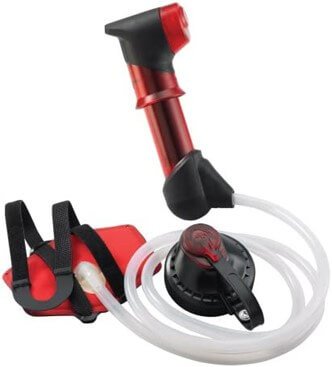
Features
- Cartridge life: 1000 Litres
- Purification method: Hollow Fibre Membrane
- Weight: 7.8 oz
- Flow rate: 3 Litres Per Minute
Pros
- Utilizes highly effective hollow fibre technology.
- Has a fast filtration rate of 3 litres per minute.
- Extremely effective against protozoa, bacteria, and particulate
- The box even includes a Quick Connect bottle adaptor, allowing direct connection to all MSR hydration products
- Also features a limited lifetime manufacturer’s warranty
Cons
- Does not have a carbon filter!
If you’re looking for an affordable, lightweight option that will keep you from getting sick on your next adventure, we highly recommend the MSR HyperFlow Backcountry Water Filter.
This filter uses hollow fibre technology to provide a fast filtration rate of 3 litres per minute, making it one of the fastest filters on the market. It’s also extremely effective against protozoa, bacteria, and particulate matter—all while fitting in your pack!
The box even includes a Quick Connect bottle adaptor, allowing direct connection to all MSR hydration products.
FAQs
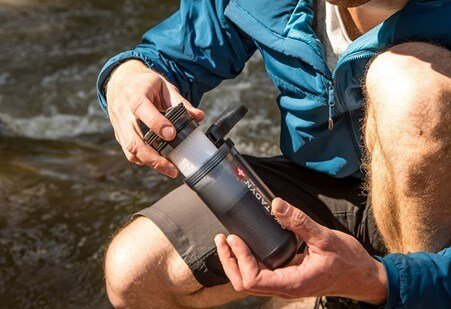
1. Which water filter removes the most contaminants?
Reverse osmosis systems are one of the most popular types of water filters on the market. They are effective at removing a wide range of contaminants from water, including bacteria, viruses, and chemicals.
In reverse osmosis systems, water is pushed through a semipermeable membrane. This membrane is designed to allow only clean water molecules to pass through it while trapping contaminants on the other side.
The majority of reverse osmosis systems will also include a carbon filter which further removes any remaining impurities before the water is sent to your tap or fridge for dispensing.
2. What’s better than the LifeStraw?
The Sawyer Mini is one of the most popular water filters on the market today, and it’s also considered as a great alternative to the LifeStraw! It is incredibly versatile and can be used in a variety of ways to ensure you have clean drinking water no matter where you are.
One of the best things about the Sawyer Mini is that it can filter out 99.9% of all bacteria, including E. coli and salmonella, as well as 99.9% of all protozoa, such as giardia and cryptosporidium. This means that you can drink from just about any source without worrying about getting sick!
Another great thing about the Sawyer Mini is its size; at only 2 ounces (57 grams), it’s one of the lightest water filters available! This makes it perfect for backpacking or travel when every ounce counts.
3. Does Katadyn filter Giardia?
Giardia is a common waterborne parasite that can cause severe gastrointestinal illness. Symptoms include diarrhoea, cramps, nausea, and vomiting. Giardia infection is often called “giardiasis” or “beaver fever.”
While there are many different types of water filters on the market, Katadyn brand filters have been shown to be effective at removing Giardia from water. In fact, tests conducted by the U.S. Environmental Protection Agency (EPA) have found that all models of Katadyn pocket filters remove 99.9% of Giardia cysts from contaminated water sources.
If you are planning to travel or camp in areas where Giardia is known to be present, using a Katadyn filter can help ensure that you and your family do not become sick!
4. Do Katadyn filters remove heavy metals?
Katadyn filters are designed to remove a wide range of contaminants from water, including heavy metals. This is accomplished through a process known as adsorption, in which particles adhere to the surface of the filter material.
Katadyn filters are made with activated carbon, which has a large surface area that can effectively trap and remove heavy metals from water. In addition, these filters also contain silver, which helps prevent bacteria growth on the filter media.
As a result, Katadyn filtered water will not only be free of harmful contaminants like lead and mercury but will also taste fresher and cleaner than unfiltered water.
5. Can you drink dirty water with LifeStraw?
You can drink dirty water with LifeStraw, but there are some things to keep in mind.
- First of all, you should only use LifeStraw to filter water that is contaminated with bacteria or parasites – not viruses.
- Additionally, while LifeStraw will remove 99.9% of bacteria and 99.9% of parasites from the water, it does not purify the water or make it safe to drink “if chemical contaminants are present.”
- Finally, remember that although you can safely drink dirty water through your LifeStraw, it’s always best to sterilize any collected water before drinking by boiling it for at least 1 minute (at elevations above 6500 feet/2000 meters boil for 3 minutes).
6. Which is better water purifier or filter?
There is no easy answer when it comes to choosing between a water purifier and filter. Both have their own pros and cons that need to be considered before making a decision.
In general, water filters are less expensive than purifiers and require less maintenance. However, they may not remove all contaminants from your water supply, so it’s important to do your research beforehand.
Water purifiers tend to be more effective at removing impurities, but they can be pricier upfront and require more frequent replacement filters. In the end, the optimal choice for you will depend on your specific needs and budget.
7. What are the 3 types of filtration?
Filtration can be classified into three types: mechanical, biological, and chemical.
- Mechanical filtration uses a physical barrier to remove particles from water. This can be done with a simple cloth filter or a more complex system like a reverse osmosis unit.
- Biological filtration relies on beneficial bacteria to break down organic matter in water. This is often done with an aquarium filter that contains media for the bacteria to grow on (such as bio balls).
- Chemical filtration removes dissolved pollutants from water using chemicals like activated carbon or zeolite crystals.
8. How do you purify water while backpacking?
One of the most important things to consider when planning a backpacking trip is how you will purify your water.
While there are several methods available, boiling or using a backpacking water filter are two of the most reliable and common ways to ensure that your water is safe to drink.
- Boiling: Boiling is one of the oldest and most effective methods for purifying drinking water. Simply bring your water to a rolling boil for 1-3 minutes (depending on elevation) and let it cool before drinking. This will kill all bacteria, viruses, and protozoa present in the water making it safe to consume.
- Backpacking Water Filters: Using a backpacker’s specific gravity filter system is another great way cleanse contaminated drinking water. This helps remove harmful microorganisms as well as many types of chemicals found naturally occurring in surface waters such as fluoride ions, chlorine compounds and heavy metals including lead!
9. Is LifeStraw safe for backpacking?
The LifeStraw is an excellent choice for backpacking, as it can filter out 99.9% of bacteria and viruses from water sources.
However, you may also want to consider other great alternatives like the Sawyer Mini Water Filter. The Sawyer Mini is incredibly lightweight and easy to use, making it a great option for backpacking trips.
10. Is filtering water safe enough when backpacking?
When it comes to backpacking and water, there are a lot of different options out there. You can choose to drink straight from the source, filter your water, or purify it. So, is filtering water enough when backpacking?
The answer really depends on the quality of the water you’re starting with. If you’re hiking in an area where the water is known to be clean (like in many parts of North America), then filtering the water will be just fine.
However, if you’re unsure about the quality of the water or if there might be harmful bacteria present, then it’s better to err on the side of caution and filtering or purifying your water instead!
Additional Resources
If you are looking for more tutorials, walkthroughs and troubleshooting about camping and enjoying the outdoors, here are some additional posts to check out:
The Bottom Line
So, there you have it: the 4 best backpacking water filtering systems. But which one is right for you?
- If you’re looking for something lightweight and easy to use, we recommend the Sawyer Mini. It’s small enough to fit in your pocket and easy to clean out when you’re done using it.
- Or if you want something more effective at removing bacteria and protozoa, but still don’t want to carry around a huge contraption, we recommend the Katadyn Hiker Pro. This one comes with all of the bells and whistles—it’s just so darn big!
- And finally, if you’re looking for an all-in-one system that removes everything from viruses down to very small parasites like cryptosporidium and giardia, then look no further than our top pick: The Survivor Filter Pro!
Thanks for reading, if you think I forgot something or if you simply want to share a story or some advice, feel free to leave your comment or opinion below. Be safe and happy adventure.!

